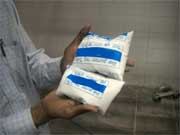|
| |
Packaged milk sold not fit for drinking
Main
Article page | Health page|
Fitness articles|
Diseases

NGO says purity tests undertaken on seven
leading brands revealed levels of bacteria and coliform count way above
permissible limits
Highlighting the level of contamination in
packaged milk available in the market, Ludhiana-based NGO Consumer
Protection Force has said purity tests undertaken on seven leading
brands sold in the market, both of co-operative and private sectors,
revealed levels of bacteria and coliform count way above the permissible
limits.
Presenting the findings, NGO president Rajiv
Tandon, however, refused to reveal the names of the brands on Sunday,
saying they did not want to target any particular manufacturer, as the
problem of contamination was similar across all the seven samples.
According to Tandon, the samples were sent to the SGS Labs in Gurgaon on
May 3 and the results were received on May 10.
“We decided to get the milk tested on two basic
parameters. One, the total plate count (TPC), which essentially shows
the total bacteria count in the milk and includes bacteria, epithelial
cells, polymorphs, lymphocytes and macrophages. Two, the coliform count
in milk, which is used as a general indicator of sanitary conditions in
dairy production and processing environments. Some coliforms can cause
illness in people, especially young children, the elderly and those with
weakened immune systems. They may cause abdominal cramps, bloody
diarrhea and acute kidney failure in severe cases,” said Tandon, while
addressing the media.
Giving the results of the lab tests, he
said, “The results were shocking. In case of the TPC, the
acceptable levels for pasteurised milk as per industry norms is
30,000 cfu/ml. If the TPC is more than 50,000 cfu/ml, the milk
is unfit for human consumption and should be destroyed. To our
disbelief, the TPC in all brands ran into lakhs, ranging from
10,00,000 cfu/ml to 6,60,00,000 cfu/ml and yet this milk is
being sold in the market with impunity. While the norm for
Coliform Count is 10 clu/ml, it ranged from 60 clu/ml to
7,10,000 clu/ml across the brands. To our mind, the milk that we
are drinking is poison and urgent steps are required by the
government to stop this mass slow poisoning.”
The NGO blamed the multiple bacteria count
on either the faulty pasteurisation process or unhygienic
conditions prevailing in the plant. “Typically, the farmer milks
the cow at around four am. An unrefrigerated tanker does the
rounds and collects milk from various collection points in
villages and transports it to the chilling centre. Usually, this
tanker reaches the centre after a gap of five to six hours. The
milk is then processed and pasteurisation takes place where,
theoretically, all bacteria should get eliminated. This,
however, is obviously not happening, either because of lapses in
the pasteurisation process or unhygienic conditions inside the
plant. The milk is then packed in pouches and again transported
in unrefrigerated vans to shops, where it lies in trays in the
open. The bacteria count multiplies at a geometric pace and that
is why it is running into crores. The milk we drink today has
most probably been milked from the cow a couple of days
earlier,” said Tandon.
Talking about the possible solutions,
Sanjeev Ghanoli, chairman of the Consumer Protection Force,
said, “It’s about time these milk companies start adopting
modern milking and packaging techniques. They have to look at
processing norms and policies followed by the European
countries, where milk is untouched by hand and hygiene standards
are maintained through mechanised milking techniques.”
- Indian Express
| |
|



